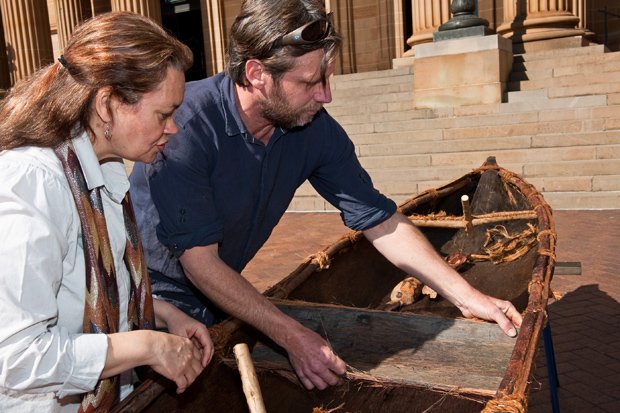Aboriginal traditional canoe recreated

MORE THAN 170 YEARS ago Aboriginal bark canoes glided on the waters of Sydney Harbour. And thanks to the efforts of a teacher, the traditional Aboriginal canoe or ‘nawi’ has come back to the city.
The replica vessel arrived at the State Library of NSW on Wednesday morning. It will be used in a major exhibition by the library titled Mari Nawi: Aboriginal Odysseys 1790 -1850. The four-metre structure was created over three years by Sydney teacher-turned-canoe-maker James Dodd, who referred to reports from the First Fleet to ensure every detail was accurate.
“It was painstaking work trying to achieve the desired nawi shape,” said James, who used traditional Aboriginal methods to build the canoe.
Stringybark trees
The nawi was carved from white stringybark sourced from Land Council trees in Nelligen, on the south coast of New South Wales, and wrapped using hand-made rope. Holes were sealed with beeswax and xanthorrea grass tree resin. In preparation for the exhibition, it will now undergo a four-week process of oxygen starvation, which will destroy any pests lurking in the wooden vessel.
Exhibition curator Dr Keith Vincent Smith said the exhibition looks at how Aboriginal men and women became involved in jobs such as boatmen, sailors, steersmen, whalers and trackers following English settlement in Sydney. “Valued for their practical skills and watercraft, (they) re-made their lives on European vessels after the smallpox epidemic had shattered half their clans,” Keith says. Their amazing journeys are now part of our maritime history.”
The exhibition name, Mari Nawi, means ‘big canoe’ and was the name given to the ships of the First Fleet by Aboriginal people. Two of these mawi nawi – the HMS Sirius and HMS Supply – will also feature in the exhibition. The large-scale models from Sydney’s Powerhouse Museum will appear alongside Aboriginal portraits, landscapes and ship paintings, maps and sketches from the era.
The exhibition at the NSW State Library is free and runs from September 20 to December 12.

